ignition switch cir MITSUBISHI 380 2005 Manual PDF
[x] Cancel search | Manufacturer: MITSUBISHI, Model Year: 2005, Model line: 380, Model: MITSUBISHI 380 2005Pages: 1500, PDF Size: 47.87 MB
Page 441 of 1500
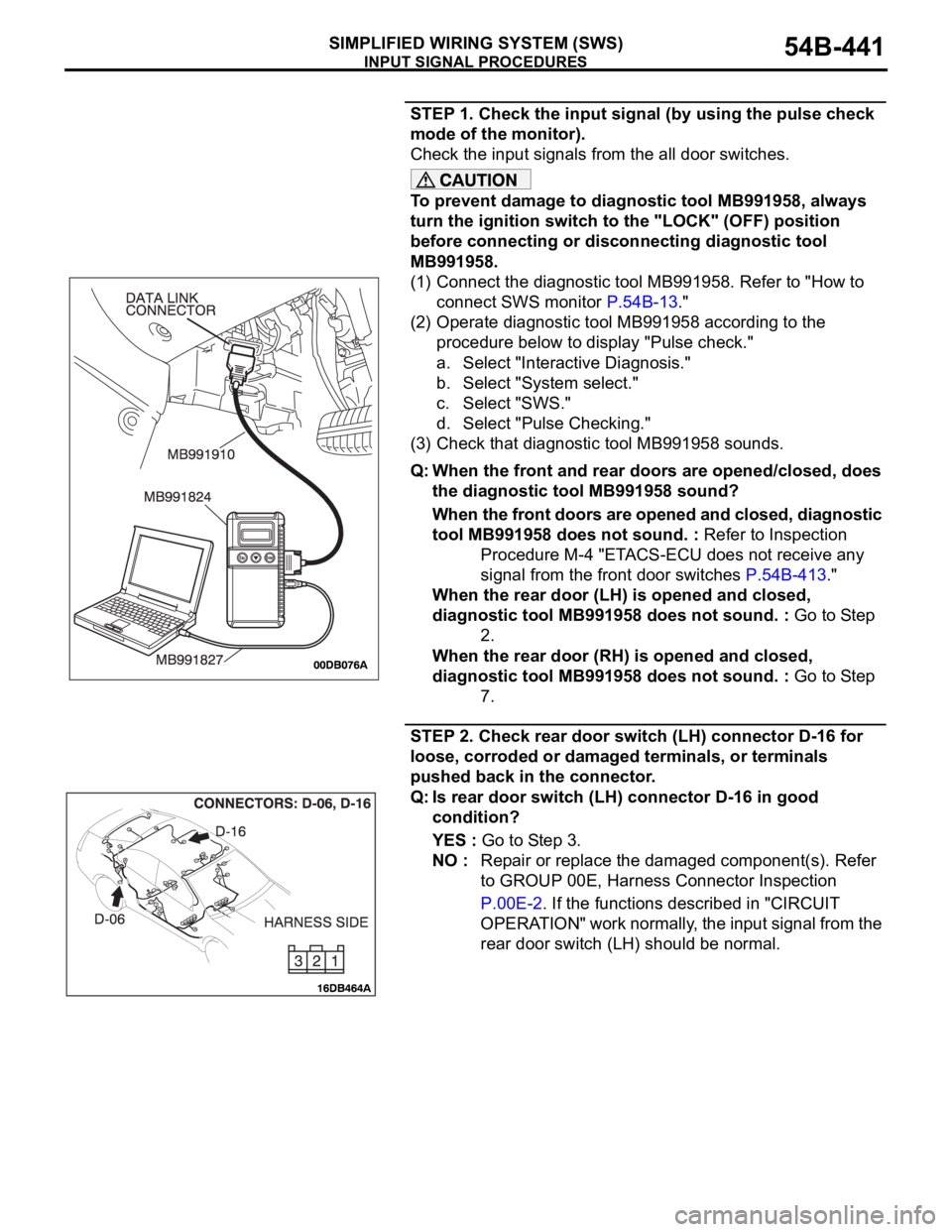
INPUT SIGNAL PROCEDURES
SIMPLIFIED WIRING SYSTEM (SWS)54B-441
STEP 1. Check the input signal (by using the pulse check
mode of the monitor).
Check the input signals from the all door switches.
To prevent damage to diagnostic tool MB991958, always
turn the ignition switch to the "LOCK" (OFF) position
before connecting or disconnecting diagnostic tool
MB991958.
(1) Connect the diagnostic tool MB991958. Refer to "How to
connect SWS monitor P.54B-13."
(2) Operate diagnostic tool MB991958 according to the
procedure below to display "Pulse check."
a. Select "Interactive Diagnosis."
b. Select "System select."
c. Select "SWS."
d. Select "Pulse Checking."
(3) Check that diagnostic tool MB991958 sounds.
Q: When the front and rear doors are opened/closed, does
the diagnostic tool MB991958 sound?
When the front doors are opened and closed, diagnostic
tool MB991958 does not sound. : Refer to Inspection
Procedure M-4 "ETACS-ECU does not receive any
signal from the front door switches P.54B-413."
When the rear door (LH) is opened and closed,
diagnostic tool MB991958 does not sound. : Go to Step
2.
When the rear door (RH) is opened and closed,
diagnostic tool MB991958 does not sound. : Go to Step
7.
STEP 2. Check rear door switch (LH) connector D-16 for
loose, corroded or damaged terminals, or terminals
pushed back in the connector.
Q: Is rear door switch (LH) connector D-16 in good
condition?
YES : Go to Step 3.
NO : Repair or replace the damaged component(s). Refer
to GROUP 00E, Harness Connector Inspection
P.00E-2. If the functions described in "CIRCUIT
OPERATION" work normally, the input signal from the
rear door switch (LH) should be normal.
Page 452 of 1500
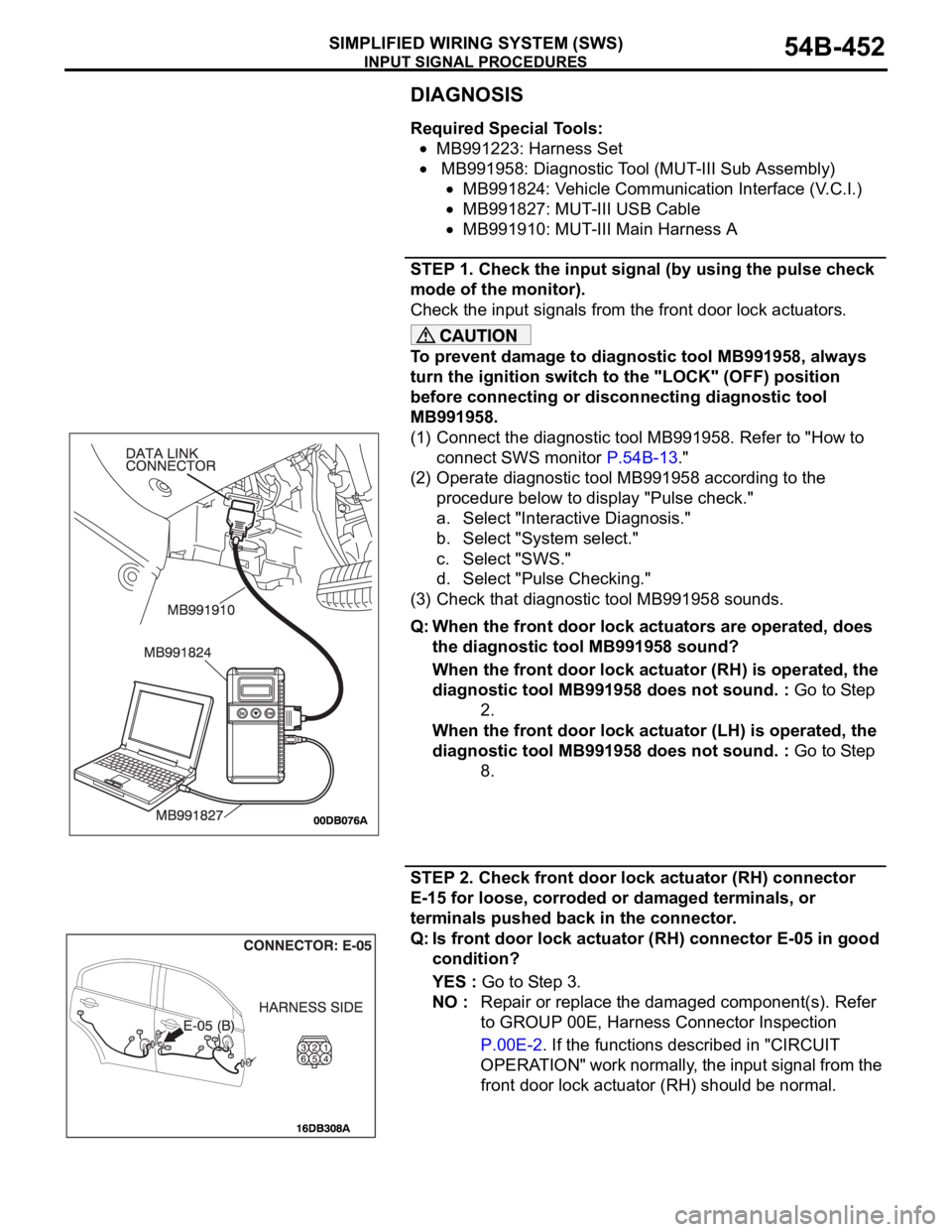
INPUT SIGNAL PROCEDURES
SIMPLIFIED WIRING SYSTEM (SWS)54B-452
DIAGNOSIS
Required Special Tools:
MB991223: Harness Set
MB991958: Diagnostic Tool (MUT-III Sub Assembly)
MB991824: Vehicle Communication Interface (V.C.I.)
MB991827: MUT-III USB Cable
MB991910: MUT-III Main Harness A
STEP 1. Check the input signal (by using the pulse check
mode of the monitor).
Check the input signals from the front door lock actuators.
To prevent damage to diagnostic tool MB991958, always
turn the ignition switch to the "LOCK" (OFF) position
before connecting or disconnecting diagnostic tool
MB991958.
(1) Connect the diagnostic tool MB991958. Refer to "How to
connect SWS monitor P.54B-13."
(2) Operate diagnostic tool MB991958 according to the
procedure below to display "Pulse check."
a. Select "Interactive Diagnosis."
b. Select "System select."
c. Select "SWS."
d. Select "Pulse Checking."
(3) Check that diagnostic tool MB991958 sounds.
Q: When the front door lock actuators are operated, does
the diagnostic tool MB991958 sound?
When the front door lock actuator (RH) is operated, the
diagnostic tool MB991958 does not sound. : Go to Step
2.
When the front door lock actuator (LH) is operated, the
diagnostic tool MB991958 does not sound. : Go to Step
8.
STEP 2. Check front door lock actuator (RH) connector
E-15 for loose, corroded or damaged terminals, or
terminals pushed back in the connector.
Q: Is front door lock actuator (RH) connector E-05 in good
condition?
YES : Go to Step 3.
NO : Repair or replace the damaged component(s). Refer
to GROUP 00E, Harness Connector Inspection
P.00E-2. If the functions described in "CIRCUIT
OPERATION" work normally, the input signal from the
front door lock actuator (RH) should be normal.
Page 477 of 1500
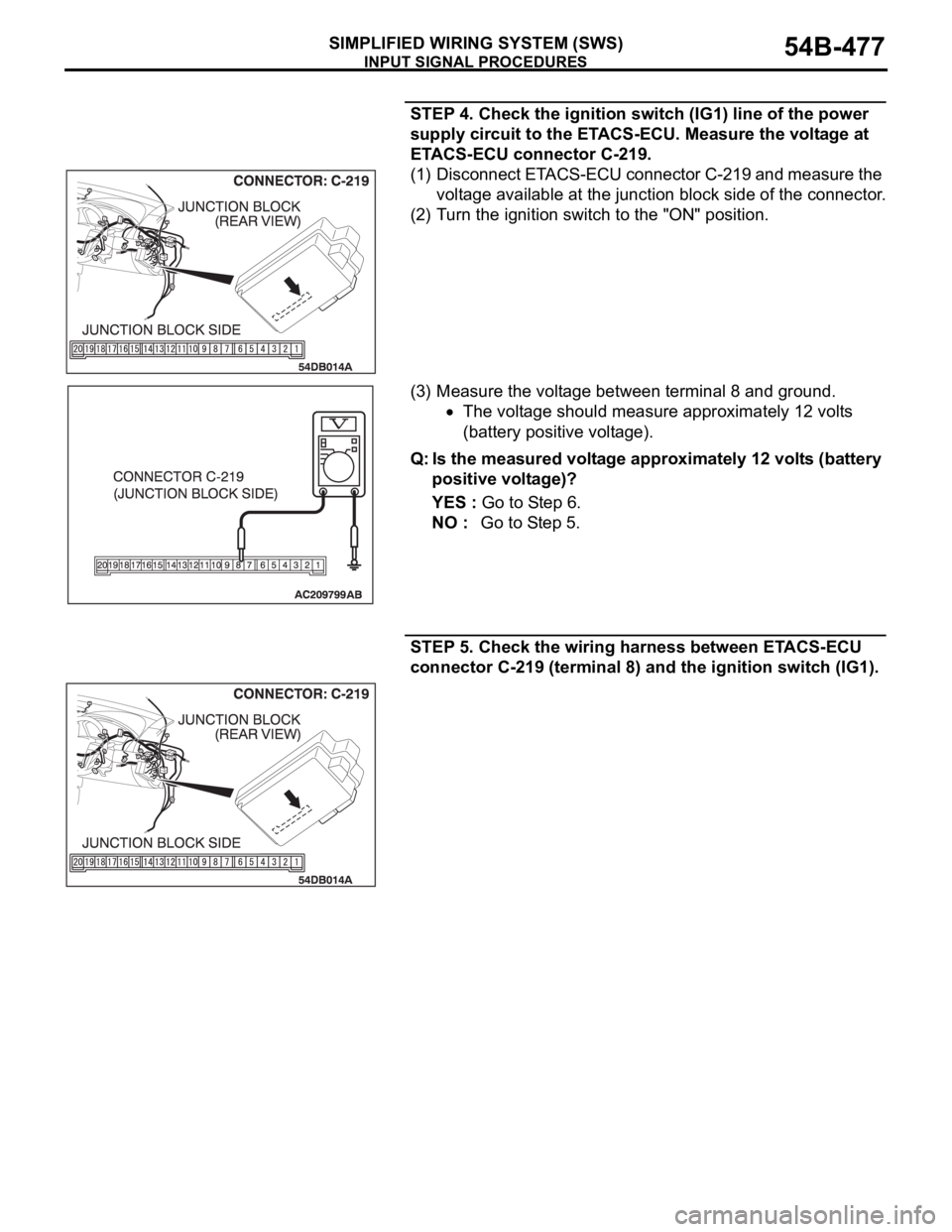
INPUT SIGNAL PROCEDURES
SIMPLIFIED WIRING SYSTEM (SWS)54B-477
STEP 4. Check the ignition switch (IG1) line of the power
supply circuit to the ETACS-ECU. Measure the voltage at
ETACS-ECU connector C-219.
(1) Disconnect ETACS-ECU connector C-219 and measure the
voltage available at the junction block side of the connector.
(2) Turn the ignition switch to the "ON" position.
(3) Measure the voltage between terminal 8 and ground.
The voltage should measure approximately 12 volts
(battery positive voltage).
Q: Is the measured voltage approximately 12 volts (battery
positive voltage)?
YES : Go to Step 6.
NO : Go to Step 5.
STEP 5. Check the wiring harness between ETACS-ECU
connector C-219 (terminal 8) and the ignition switch (IG1).
Page 478 of 1500
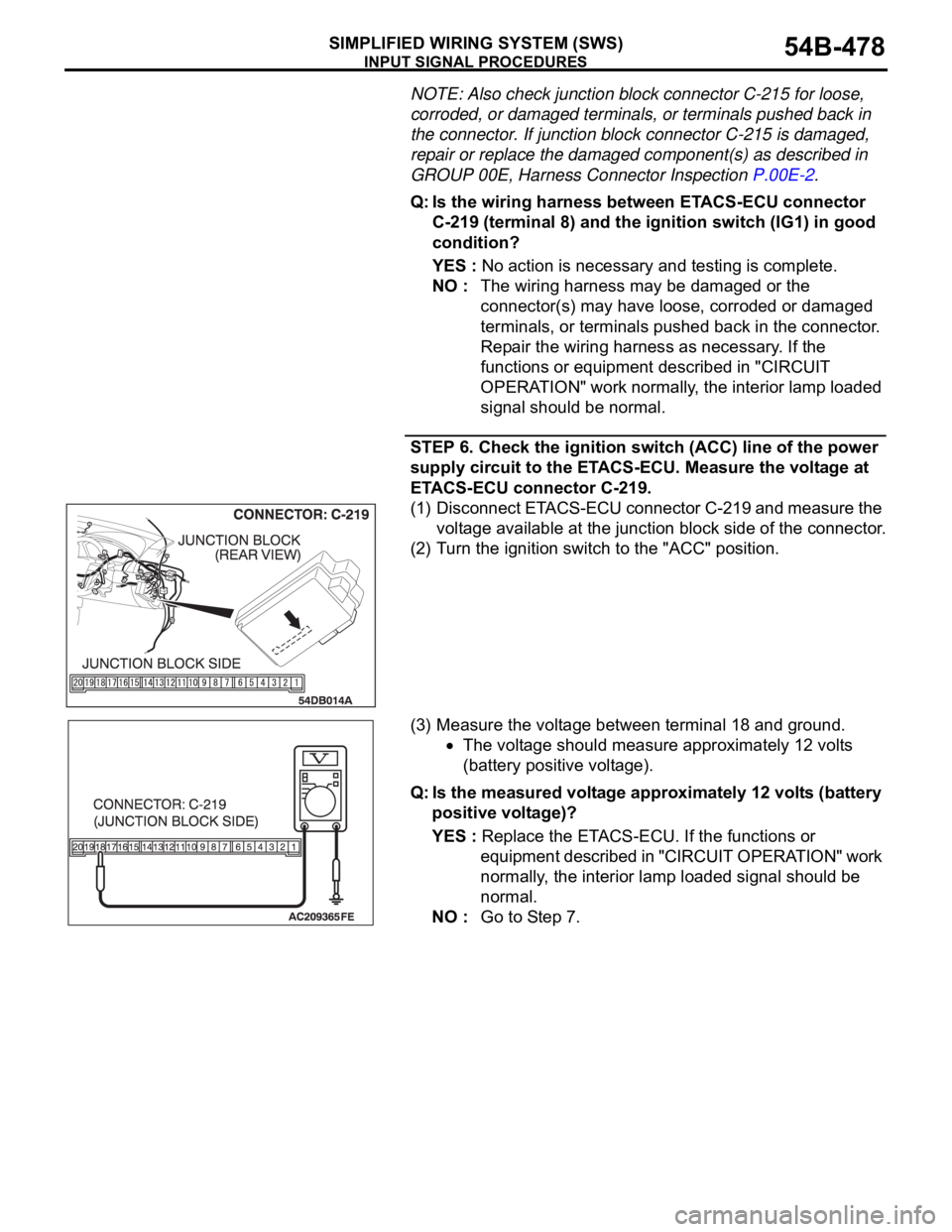
INPUT SIGNAL PROCEDURES
SIMPLIFIED WIRING SYSTEM (SWS)54B-478
NOTE: Also check junction block connector C-215 for loose,
corroded, or damaged terminals, or terminals pushed back in
the connector. If junction block connector C-215 is damaged,
repair or replace the damaged component(s) as described in
GROUP 00E, Harness Connector Inspection P.00E-2.
Q: Is the wiring harness between ETACS-ECU connector
C-219 (terminal 8) and the ignition switch (IG1) in good
condition?
YES : No action is necessary and testing is complete.
NO : The wiring harness may be damaged or the
connector(s) may have loose, corroded or damaged
terminals, or terminals pushed back in the connector.
Repair the wiring harness as necessary. If the
functions or equipment described in "CIRCUIT
OPERATION" work normally, the interior lamp loaded
signal should be normal.
STEP 6. Check the ignition switch (ACC) line of the power
supply circuit to the ETACS-ECU. Measure the voltage at
ETACS-ECU connector C-219.
(1) Disconnect ETACS-ECU connector C-219 and measure the
voltage available at the junction block side of the connector.
(2) Turn the ignition switch to the "ACC" position.
(3) Measure the voltage between terminal 18 and ground.
The voltage should measure approximately 12 volts
(battery positive voltage).
Q: Is the measured voltage approximately 12 volts (battery
positive voltage)?
YES : Replace the ETACS-ECU. If the functions or
equipment described in "CIRCUIT OPERATION" work
normally, the interior lamp loaded signal should be
normal.
NO : Go to Step 7.
Page 479 of 1500
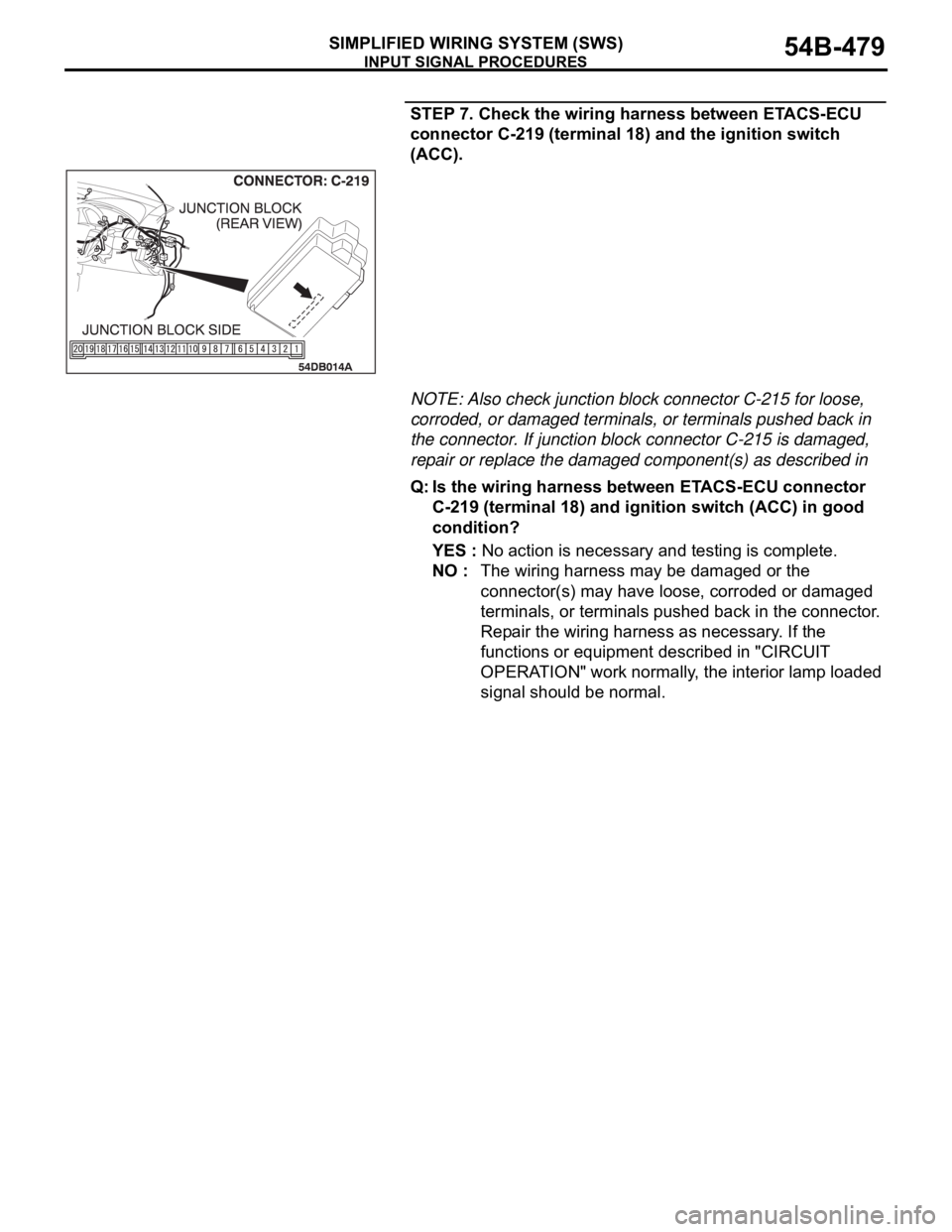
INPUT SIGNAL PROCEDURES
SIMPLIFIED WIRING SYSTEM (SWS)54B-479
STEP 7. Check the wiring harness between ETACS-ECU
connector C-219 (terminal 18) and the ignition switch
(ACC).
NOTE: Also check junction block connector C-215 for loose,
corroded, or damaged terminals, or terminals pushed back in
the connector. If junction block connector C-215 is damaged,
repair or replace the damaged component(s) as described in
Q: Is the wiring harness between ETACS-ECU connector
C-219 (terminal 18) and ignition switch (ACC) in good
condition?
YES : No action is necessary and testing is complete.
NO : The wiring harness may be damaged or the
connector(s) may have loose, corroded or damaged
terminals, or terminals pushed back in the connector.
Repair the wiring harness as necessary. If the
functions or equipment described in "CIRCUIT
OPERATION" work normally, the interior lamp loaded
signal should be normal.
Page 589 of 1500

CENTRALISED JUNCTION
CIRCUIT DIAGRAMS90-12
CENTRALISED JUNCTIONM1901000301013
FUSIBLE LINK AND FUSE
ENGINE COMPARTMENT
NO. POWER SUPPLY
CIRCUITNAME RATED
CAPACITY (A)HOUSING
COLOURLOAD CIRCUIT
1 Battery/Alternator
(Fusible link No.27)Fusible
link80 Black Fuse Nos.5, 6, 9 and 10 (in junction
block) circuit
2 50 Blue Radiator fan motor
3 30 Pink ABS-ECU and ABS/TCL-ECU (motor
power supply)
4 40 Green Ignition switch circuit
5 40 Green Fuse Nos.3 and 4 (in junction block
circuit), front power window regulator
motor, power seat assembly, power
window main switch and rear power
window regulator motor
6 Fuse 15 Blue Fog lamp and fog lamp relay
720Yellow
8 15 Red Horn (High), horn (Low) and horn
relay
9 20 Yellow Camshaft position sensor, crankshaft
position sensor, engine oil control
valve, evaporative emission purge
solenoid, evaporative emission
ventilation solenoid, heated oxygen
sensor,ETACS-ECU, injector, mass
airflow sensor, MPI relay, Engine
ECU, A/T ECU, throttle actuator
control motor relay and fan control
relay
10 10 Red A/C compressor assembly and
A/C-ECU
11 15 Blue ABS-ECU, ABS/TCL-ECU,
high-mounted stoplamp, Engine ECU
and rear combination lamp
12
13 7.5 Brown
Alternator
14 10 Red ETACS-ECU, Hazard lamps
15 20 Yellow A/T control solenoid valve and Engine
ECU
16 Front-ECU
(Headlamp relay:
High)15 Blue Headlamp (RH) and headlamp (High:
RH)
17 15 Blue Headlamp (LH) and headlamp (High:
LH)
18 Front-ECU (Field
effect transistor for
headlamp: Low)10 Red Headlamp (RH) and headlamp (Low:
RH)
Page 590 of 1500

CENTRALISED JUNCTION
CIRCUIT DIAGRAMS90-13
19 Front-ECU (Field
effect transistor for
headlamp: Low)Fuse 10 Red Headlamp (LH) and headlamp (Low:
LH)
20 Front-ECU (Taillamp
relay)7.5 Brown A/C-ECU, A/T selector lever position
illumination lamp, combination meter,
fog lamp switch, headlamp (RH),
glove box lamp, hazard warning lamp
switch, multi-center display unit,
radio, CD player, rear combination
lamp (RH), rheostat and TCL switch
21 7.5 Brown Headlamp (LH), license plate lamp
and rear combination lamp (LH)
22 Battery/Alternator
(Fusible link No.27)15 Blue A/C-ECU, column switch,
combination meter, ETACS-ECU,
front-ECU, key reminder switch, multi-
center display unit, radio, CD player,
and vanity mirror lamp
23 Ignition switch (ACC) 10 Red A/C-ECU, accessory socket relay,
ETACS-ECU, multi-center display
unit, radio, CD player.
24 Battery/Alternator
(Fusible link No.27)15 Blue Fuel pump module
25 Ignition switch (ACC) 30 Green Front-ECU and windshield wiper
motor
26 Battery/Alternator
(Fusible link No.27)Fusible
link20 Light blue Anti-lock braking system(solenoid
valve)
27
Alternator120
Battery, front-ECU, fusible link Nos.1,
2, 3, 4, 5 and 26 and fuse Nos.6, 7, 8,
9, 10, 11, 13, 14, 15, 22 and 24 (in
relay box) NO. POWER SUPPLY
CIRCUITNAME RATED
CAPACITY (A)HOUSING
COLOURLOAD CIRCUIT
Page 592 of 1500

CENTRALISED JUNCTION
CIRCUIT DIAGRAMS90-15
NO. POWER SUPPLY
CIRCUITNAME RATED
CAPACITY (A)HOUSING
COLOURLOAD CIRCUIT
1 Fusible link No.1 Fuse 30 Green Rear window demister
2 30 Green Blower motor and resistor
3
4
5 15 Blue Accessory socket
6 15 Blue Data link connector and ETACS-ECU
7 Ignition switch (ACC) 15 Blue ETACS-ECU
8
9 Ignition switch (IG2) 7.5 Brown Sunroof assembly
10 Ignition switch (ACC) 7.5 Brown Remote controlled mirror
11
12
13 Ignition switch (IG1) 7.5 Brown Fuel pump relay and Engine ECU
14 Ignition switch (ACC) 20 Yellow Windscreen wiper
15 Fusible link No.1
(Fuse No.5 in junction
block)7.5 Brown Remote controlled mirror
16 Ignition switch (IG2) 7.5 Brown A/C compressor clutch relay,
A/C-ECU, blower relay, condenser
fan motor, fan control relay,
front-ECU, outside/inside air selection
damper control motor and rear
window defogger relay
17 Ignition switch (IG1)
18 7.5 Brown A/T control relay, input shaft speed
sensor, output shaft speed sensor,
Engine ECU, rear combination lamp
and SRS-ECU
19 7.5 Brown ABS-ECU, ABS/TCL-ECU, column
switch, combination meter,
ETACS-ECU, multi-center display unit
and SRS-ECU
20 10 Red Ignition coil
21
22
23 Fusible link No.5 20 Yellow Sunroof assembly
24
Page 705 of 1500

GENERAL DESCRIPTION
HEATER, AIR CONDITIONING AND VENTILATION55-4
OPERATION
.
CONDENSER FAN AND RADIATOR FAN
CONTROL
The ECU judges the required revolution speed of
radiator fan motor and condenser fan motor using
the input signals transmitted from A/C switch, output
shaft speed sensor and engine coolant temperature
sensor. The ECU activates the fan control relays to
drive the radiator fan motor and condenser fan
motor.
.
COMPRESSOR CONTROL
When operating the air conditioning switch
The air thermo sensor, which senses the temper-
ature of the air flowing out of the evaporator,
deactivates the compressor at 3
C (37.4F) or
below.
The dual pressure switch turns OFF when the
refrigerant pressure becomes excessively high or
low, thus protecting the compressor circuit (See
Table below).
When the air thermo sensor is activated, and the
ignition switch, blower switch, and air condition-
ing switch are ON, the A/C compressor clutch
relay is energized.
When operating the mode selection dial
The air conditioning will work when the mode
selection dial is set to the "Defroster" or
"Defroster/foot" position, or the temperature con-
trol dial is set to the "MAX A/C" position. In other
dial positions, when the air conditioning switch is
turned on, the air conditioning will work.
A/C Compressor Clutch Relay ON Conditions
Ignition switch (IG2) ONNOTE: A/C compressor clutch relay is
de-energized when any one switch, sensor
or control unit shown on the left turns off.
NOTE: The components marked by
*
communicate with the ECU. If the air thermo
sensor detects a temperature of 3
C
(37.4
F), the A/C-ECU will turn off the A/C
compressor clutch relay. Blower switch ON
Air conditioning switch, mode selection dial
defroster, defroster/foot position or temperature
control MAX A/CON
Air thermo sensor*
Pressure detected
by A/C pressure
sensor2940 kPa or less (If the
refrigerant pressure exceeds
2940 kPa, A/C compressor
clutch relay is not ON
condition until the refrigerant
pressure has been measured
up to 2350 kPa or less.)ON
190 kPa or more (If the
refrigerant pressure falls short
of 190 kPa, A/C compressor
clutch relay is not ON
condition until the refrigerant
pressure has been measured
up to 220 kPa or more.)
A/C compressor clutch relay driving transistor (within
ecu)ON
Page 710 of 1500
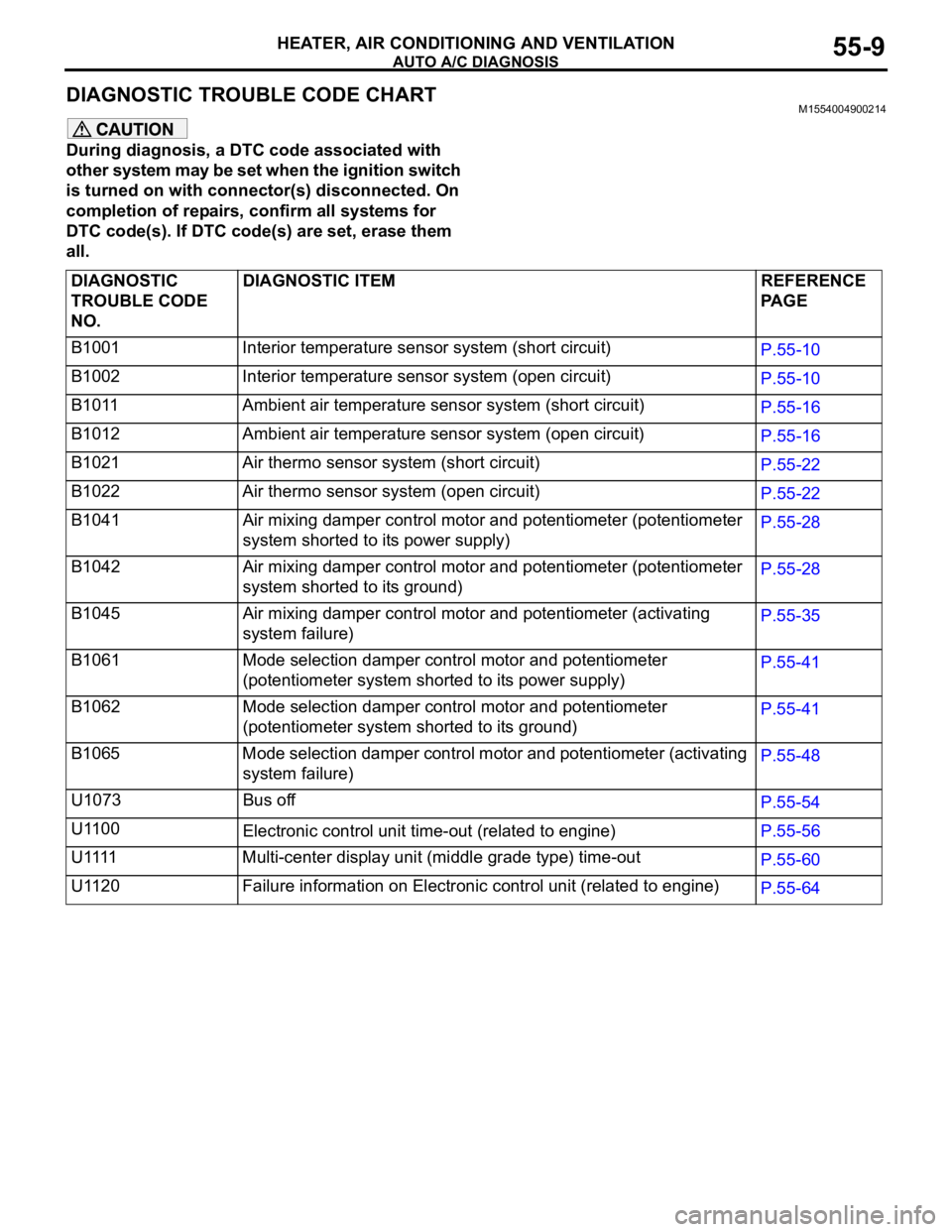
AUTO A/C DIAGNOSIS
HEATER, AIR CONDITIONING AND VENTILATION55-9
DIAGNOSTIC TROUBLE CODE CHART M1554004900214
During diagnosis, a DTC code associated with
other system may be set when the ignition switch
is turned on with connector(s) disconnected. On
completion of repairs, confirm all systems for
DTC code(s). If DTC code(s) are set, erase them
all.
DIAGNOSTIC
TROUBLE CODE
NO.DIAGNOSTIC ITEM REFERENCE
PA G E
B1001 Interior temperature sensor system (short circuit)
P.55-10
B1002 Interior temperature sensor system (open circuit)
P.55-10
B1011 Ambient air temperature sensor system (short circuit)
P.55-16
B1012 Ambient air temperature sensor system (open circuit)
P.55-16
B1021 Air thermo sensor system (short circuit)
P.55-22
B1022 Air thermo sensor system (open circuit)
P.55-22
B1041 Air mixing damper control motor and potentiometer (potentiometer
system shorted to its power supply)P.55-28
B1042 Air mixing damper control motor and potentiometer (potentiometer
system shorted to its ground)P.55-28
B1045 Air mixing damper control motor and potentiometer (activating
system failure)P.55-35
B1061 Mode selection damper control motor and potentiometer
(potentiometer system shorted to its power supply)P.55-41
B1062 Mode selection damper control motor and potentiometer
(potentiometer system shorted to its ground)P.55-41
B1065 Mode selection damper control motor and potentiometer (activating
system failure)P.55-48
U1073 Bus off
P.55-54
U1100
Electronic control unit time-out (related to engine)P.55-56
U 1111 M u l t i - c e n t e r d i s p l a y u n i t ( m i d d l e g r a d e t y p e ) t i m e - o u t
P.55-60
U1120 Failure information on Electronic control unit (related to engine)
P.55-64